Acer was focusing heavily on its client devices including notebooks and Chromebooks.
Asus has had larger displays in its range for some years, but, so far, has only promoted the range in a limited way. That is likely to change as the B2B side of the company (which it calls the ‘Open Platform group’ to differentiate from the client device group) wants to increase its share. At the show, the company told us it has 32″/42″/46″/50″/55″ and 65″ in the large format range, with 55″ and 65″ using infrared touch.
Avocor (previously VividTouch) was back at the show with an E Series of infrared-based FullHD displays with integrated Windows 10 and due in Q2. The company started its offer with higher end systems using FlatFrog last year. It is also updating its X series of higher end products which will support 20 points of touch with InGlass touch in 65″, 75″ and 84″ and with UltraHD resolution. They will be available in Q2 with an active pen. (It turns out that Avocor’s office is very close to the Display Daily office, so we plan a meeting soon). The company is also developing its wireless connectivity using Wi-Fi Direct.
BenQ moved this year from the back of the hall (with a meeting room) to the front of the hall. We looked at the latest 75″ interactive display (there will later be 65″ and 70″ versions) which uses a new soundbar that provides 16W per channel of audio. The bar includes new functions such as a proximity sensor which can be used to reduce power consumption. It also has a programmable NFC point that can be used a variety of purposes. At the show, it was being used with pens and the NFC reacted by changing the colour being drawn by putting the appropriate pen on the NFC point. The NFC point can be used to lock the panel or support other security operations. The 75″ will start to ship in March.
 Clevertouch remains a major supplier in the market for education and the company told us that it has switched to 100% UltraHD panels in its displays now. The company was showing how its displays can support Windows as well as running Android on its integrated processor and with a new front end, called Lux. The company told us that one of the key features is that switching between the platforms is very simple. It also has new Lynx 5 presentation software. However, at the show, its main promotion was of its cloud-based content and App store. Using the cloud platform, managers can control and update content for multiple sites or complete districts.
Clevertouch remains a major supplier in the market for education and the company told us that it has switched to 100% UltraHD panels in its displays now. The company was showing how its displays can support Windows as well as running Android on its integrated processor and with a new front end, called Lux. The company told us that one of the key features is that switching between the platforms is very simple. It also has new Lynx 5 presentation software. However, at the show, its main promotion was of its cloud-based content and App store. Using the cloud platform, managers can control and update content for multiple sites or complete districts.
CTouch of the Netherlands was showing a new version of its educational software. The company also told us that it is transitioning from 84″ to 86″ at the large end of its range. It still supports 55″, 65″ and 70″ in FullHD as well as 65″/75″ and 84″ in UltraHD. It calls its touch technology Laser Air and can support 32 point touch. The displays have an unusual level of audio power with 80W speakers from JBL Harman. CTouch has a remote pointing device that is based on the U-Wand remote control technology which uses absolute positioning, rather than the relative positioning of other solutions and that means that it is easier to keep track of where the cursor is.
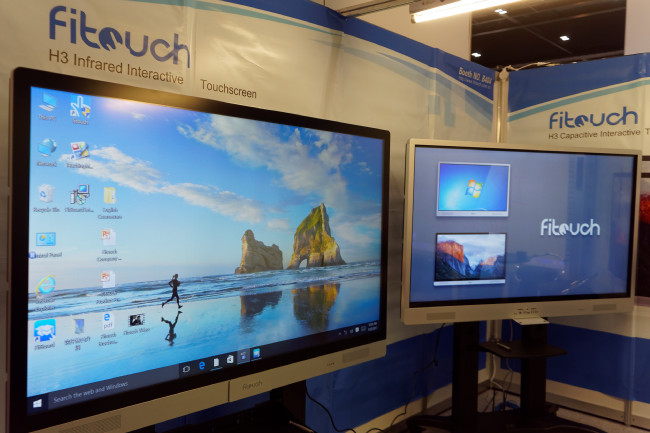
Fitouch was showing interactive displays with infrared and capacitive touch. The company can make displays from 55″ to 98″ (although it could go up to 130″ if needed). The company told us that the infrared technology being used is the firm’s own. The PCap touch system used a copper metal mesh system that was visible on certain image backgrounds.
Genee World has a range of products including IWBs and infrared-based interactive LCDs. The company has a range of solutions from 21″ to 101″ and told us that it focuses on complete software and hardware solutions. The main market is education and the firm told us that it is developing PCap technology for the future. It currently supports 32″ to 42″ with that technology.
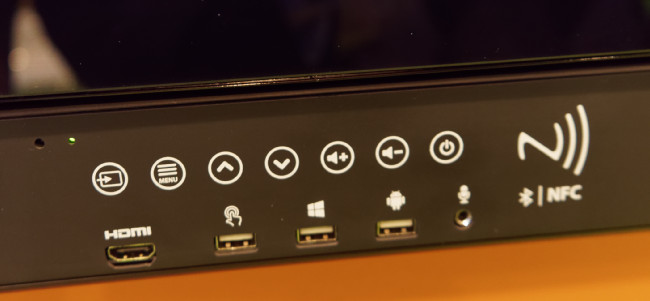
Hanshin Board was showing a ‘flip chart’ noteboard, Interactive whiteboards based on projection and flat panels from 65″ to 84″. There is a new design for the firm’s flat panels and it has plans to boost its PCap technology and add anti-glare and anti-friction coatings as well as optical bonding. A special feature is an NFC. The function of the NFC pad can be programmed, so it can be used to power the display on or off or to control security.
Hanshin was also showing its eFun touch table, but this product is basically the same as was shown last year.
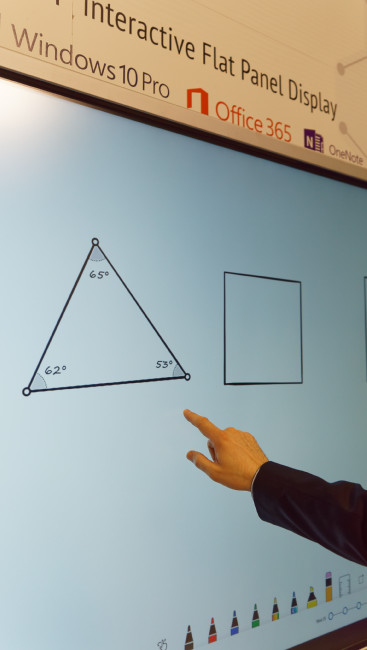
On a partner stand, Microsoft was showing a new interactive whiteboard application that Microsoft is planning to provide on a no charge basis at some point in the future. The application uses some of Microsoft’s Ink technology. For example, a hand drawn triangle is converted to a vector shape with straight lines. The shape created in the application can have its corners manipulated and shows the angles of each corner. The software can also automatically covnert handwriting to text and search using Bing.
Microsoft is developing a Classroom Platform and that includes integration with OneNote and can offer features such as using a url to connect to a display.
Opton (Shunchang) Optics Co Ltd is from China and was showing an 84″ touch display with 60 point touch and available at around $15,000. Metal mesh is used for the sensor and the display uses Anti-Glare (AG) optical glass with direct bonding. The display supports 60 points of touch. The company makes displays from 55″ and can also offer non-bonded displays either under its own brand or for OEMs.
The first company that we met with at the BETT show was Promethean, which has now been owned by NetDragon in China. The company is looking to a wider future range of technologies and services and was giving potential customers an idea about this in a presentation room away from the show floor.
In terms of hardware, Promethean continues to offer 70″ and 75″ FullHD displays and 75″ and 86″ UltraHD in its new ‘Series 5’ displays and the company is using the FlatFrog technology (which is winning wide support in this application at the high end DD Link), which it calls ‘InGlass’ touch. The company has developed a new generation of its Classflow Desktop which is built on a new code base. As well as working completely offline, the software can support cloud-based operation.
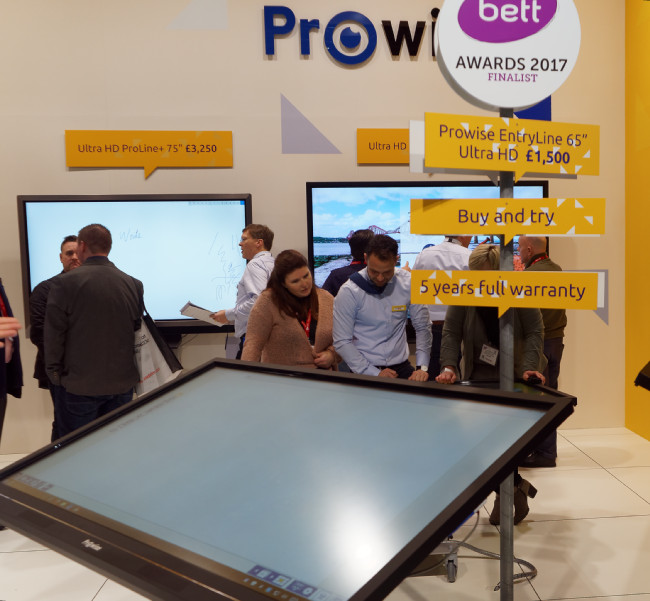
ProWise has been in the market for touch displays since 2009 and is based in the Netherlands. The company was promoting its displays which are from 55″ to 86″ as good value (a 65″ UltraHD system was shown at £1,500/$1,900 and a 75″ at £3,250/$4,100 at the event). The company told us that it develops its own hardware and software. The company offers a five year warranty on its products and in the UK and the Netherlands, it sells directly to resellers. It uses distribution in the Nordics and is looking to expand its business in the US and Australia, which it sees as expanding markets.
At the show, ProWise was emphasising that its pen technology supports the Microsoft Ink specification, so it can be used directly in Microsoft’s apps such as OneNote. The company has a new Android module that is upgradable and of its own design. The company told us that it is looking to use OPS in the future.
Shenzen 3D Technology was showing an 85″ passive stereo 3D touch display that it is promoting to educators. We asked the company what it would do, now that LG Display is no longer supplying passive 3D panels? The company told us that it is getting good cooperation from BOE and was optimistic of being able to buy passive panels from the company. The firm uses metal mesh technology to support PCap touch.
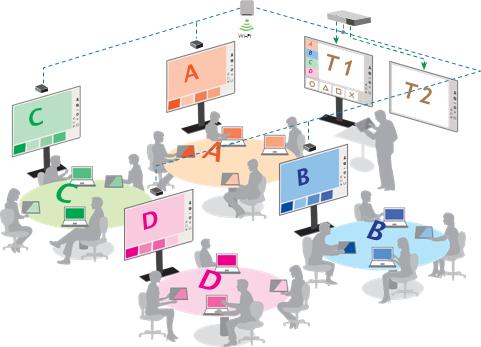
Sony was at the show to present its collaboration solutions for University level applications which it is selling as a complete software/hardware solution under the name “Vision Exchange”. In recent years, there has been a big move away from the traditional lecturing process and to try to get students more actively involved in the learning process. Sony has developed a complete software solution that allows an educator to run a number of individual groups from a central point and both monitor and share screens. Groups can cluster around individual group displays and share content from their client devices, based on iOS, Android or Windows. Up to six separate sub groups are supported.
The system runs completely locally on university networks and doesn’t need access to the cloud. There were no new hardware products being promoted at the show.
Vestel was at the show with a range of interactive displays for education and business and with a range of 55″ to 84″. The company has been catching up with features that users have asked for. The company now has faster touch (said to be 9ms response) and has also upgraded the features on its digital signage range. These are now available in 16/7 as well as 24/7 configurations and features that have been added include autolaunch from USB and autolaunch on no signal detect.

